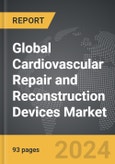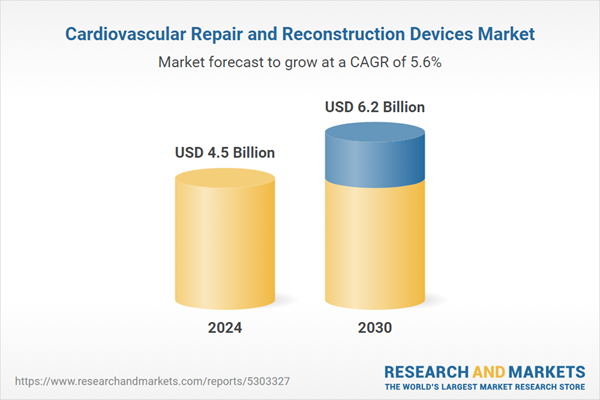Global Cardiovascular Repair and Reconstruction Devices Market - Key Trends & Drivers Summarized
Why Are Cardiovascular Repair and Reconstruction Devices Vital in Modern Healthcare?
Cardiovascular repair and reconstruction devices are essential tools used in surgeries to restore the function and structure of damaged blood vessels, heart tissues, and other cardiovascular components. These devices include stents, grafts, patches, and occluders, which are used to treat various cardiovascular conditions such as coronary artery disease, congenital heart defects, aneurysms, and valvular disorders. With cardiovascular diseases (CVDs) being the leading cause of death worldwide, these devices play a critical role in addressing heart-related health issues, helping to save lives and improve the quality of life for millions of patients.The increasing incidence of heart diseases, fueled by risk factors like aging populations, unhealthy lifestyles, obesity, and hypertension, has driven demand for these devices. Cardiovascular repair and reconstruction devices are used in both emergency interventions and planned surgeries to prevent heart failure, strokes, and other serious complications. Additionally, advances in surgical techniques and materials used in these devices, such as bioengineered grafts and minimally invasive stents, have improved patient outcomes, making these devices even more integral to modern healthcare.
How Are Technological Innovations Shaping the Cardiovascular Repair and Reconstruction Devices Market?
Technological innovations are driving significant advancements in cardiovascular repair and reconstruction devices, enhancing their performance, safety, and ease of use. One of the most important developments is the rise of minimally invasive technologies, such as percutaneous coronary intervention (PCI) and transcatheter procedures. These techniques use small incisions and catheters to repair or replace heart structures, reducing the need for open-heart surgery. Devices like stents and occluders, which are implanted through minimally invasive methods, have become the standard for treating blockages and structural heart defects. For example, the advent of drug-eluting stents (DES) has revolutionized the treatment of coronary artery disease by reducing restenosis (re-narrowing of arteries) and improving long-term outcomes for patients.Another key advancement is the development of bioresorbable and bioengineered materials in vascular grafts and patches. These materials gradually integrate into the patient's body, promoting natural tissue regeneration and reducing the risk of complications such as infection or graft rejection. Hybrid devices, combining biological and synthetic materials, are also gaining popularity for their ability to offer strength and flexibility while supporting the body's natural healing process. Additionally, 3D printing and tissue engineering technologies are making customized cardiovascular devices a reality, allowing for patient-specific solutions that improve surgical precision and outcomes.
What Medical and Consumer Trends Are Driving the Demand for Cardiovascular Repair and Reconstruction Devices?
Several medical and consumer trends are shaping the demand for cardiovascular repair and reconstruction devices, particularly the rising prevalence of cardiovascular diseases and the growing preference for minimally invasive procedures. As heart disease continues to be a major global health concern, the number of surgeries related to heart defects, aneurysms, and arterial blockages is increasing, driving the demand for advanced devices that can restore cardiovascular function effectively. Moreover, the aging population, particularly in developed countries, is contributing to the rising incidence of heart-related conditions, as older adults are more likely to require interventions for coronary artery disease, valvular disorders, and aortic aneurysms.Minimally invasive procedures are increasingly becoming the preferred option for both patients and surgeons due to their reduced recovery times, fewer complications, and shorter hospital stays. This trend is fueling the demand for devices that can be used in transcatheter and endovascular surgeries, such as stents, occluders, and synthetic grafts. Patients are now more informed about their treatment options and are opting for procedures that offer quicker recovery and lower risks. The rise of outpatient cardiovascular procedures is also contributing to the growth of the market, as healthcare providers seek devices that allow for efficient and safe same-day surgeries.
Additionally, the increasing awareness of heart health and preventive care is leading to earlier diagnosis and treatment of cardiovascular conditions. Patients diagnosed with heart disease at earlier stages are undergoing preventive surgeries and procedures, which drives demand for devices that can correct structural heart issues before they become life-threatening. The expansion of healthcare infrastructure in emerging markets, coupled with growing healthcare spending, is also increasing access to cardiovascular repair and reconstruction devices, broadening the global market.
The Growth in the Cardiovascular Repair and Reconstruction Devices Market Is Driven by Several Factors
The growth in the cardiovascular repair and reconstruction devices market is driven by several factors, including the rising global burden of cardiovascular diseases, advancements in medical technologies, and the increasing preference for minimally invasive surgical interventions. One of the primary growth drivers is the escalating incidence of heart diseases, which has created a surge in the demand for effective treatment options. Cardiovascular repair devices such as stents, grafts, and occluders are being used more frequently to address conditions like coronary artery disease, congenital heart defects, and aneurysms, as early intervention becomes critical in preventing complications like heart failure and stroke.Technological advancements in the design and materials used in cardiovascular devices are also accelerating market growth. The development of bioresorbable stents, bioengineered grafts, and hybrid devices that support tissue regeneration is offering better outcomes for patients while reducing the risks associated with traditional materials. Furthermore, the rise of minimally invasive techniques like transcatheter valve replacement (TAVR) and percutaneous coronary interventions is driving the demand for devices that enable less invasive, yet highly effective, procedures. These devices allow surgeons to perform complex repairs with minimal recovery time, aligning with patient preferences for quicker, less painful recoveries. The expansion of healthcare systems in emerging markets and the increasing availability of advanced cardiovascular care are opening new opportunities for growth. As countries in Asia, Latin America, and Africa invest in healthcare infrastructure, access to cardiovascular repair surgeries is expanding, driving demand for the devices used in these procedures. The growing focus on preventive heart care, combined with rising healthcare expenditures globally, is expected to continue driving the market for cardiovascular repair and reconstruction devices in the coming years.
Report Scope
The report analyzes the Cardiovascular Repair and Reconstruction Devices market, presented in terms of market value (US$ Thousand). The analysis covers the key segments and geographic regions outlined below.- Segments: Product (Cardiovascular Grafts, Cardiovascular Patches, Heart Valve Repair).
- Geographic Regions/Countries:World; United States; Canada; Japan; China; Europe (France; Germany; Italy; United Kingdom; Spain; Russia; and Rest of Europe); Asia-Pacific (Australia; India; South Korea; and Rest of Asia-Pacific); Latin America (Argentina; Brazil; Mexico; and Rest of Latin America); Middle East (Iran; Israel; Saudi Arabia; United Arab Emirates; and Rest of Middle East); and Africa.
Key Insights:
- Market Growth: Understand the significant growth trajectory of the Cardiovascular Grafts segment, which is expected to reach US$4.3 Billion by 2030 with a CAGR of a 5.4%. The Cardiovascular Patches segment is also set to grow at 6.1% CAGR over the analysis period.
- Regional Analysis: Gain insights into the U.S. market, valued at $1.2 Billion in 2024, and China, forecasted to grow at an impressive 8.7% CAGR to reach $1.4 Billion by 2030. Discover growth trends in other key regions, including Japan, Canada, Germany, and the Asia-Pacific.
Why You Should Buy This Report:
- Detailed Market Analysis: Access a thorough analysis of the Global Cardiovascular Repair and Reconstruction Devices Market, covering all major geographic regions and market segments.
- Competitive Insights: Get an overview of the competitive landscape, including the market presence of major players across different geographies.
- Future Trends and Drivers: Understand the key trends and drivers shaping the future of the Global Cardiovascular Repair and Reconstruction Devices Market.
- Actionable Insights: Benefit from actionable insights that can help you identify new revenue opportunities and make strategic business decisions.
Key Questions Answered:
- How is the Global Cardiovascular Repair and Reconstruction Devices Market expected to evolve by 2030?
- What are the main drivers and restraints affecting the market?
- Which market segments will grow the most over the forecast period?
- How will market shares for different regions and segments change by 2030?
- Who are the leading players in the market, and what are their prospects?
Report Features:
- Comprehensive Market Data: Independent analysis of annual sales and market forecasts in US$ Million from 2024 to 2030.
- In-Depth Regional Analysis: Detailed insights into key markets, including the U.S., China, Japan, Canada, Europe, Asia-Pacific, Latin America, Middle East, and Africa.
- Company Profiles: Coverage of players such as Abbotts, Admedus Ltd, Bard Peripheral Vascular, BD, CorMatrix and more.
- Complimentary Updates: Receive free report updates for one year to keep you informed of the latest market developments.
Some of the 42 companies featured in this Cardiovascular Repair and Reconstruction Devices market report include:
- Abbotts
- Admedus Ltd
- Bard Peripheral Vascular
- BD
- CorMatrix
- Cryolife
- Edwards Lifesciences Corporation
- Getinge AB
- LeMaitre Vascular Inc.
- MAQUET Cardiovascular LLC
- Medtronic
- Reverse Medical Corporation
- St Jude Medical
- Synovis Micro Companies Alliance Inc.
- Terumo Medical Corporation
- VASCUTEK Ltd.(subsidiary of the Terumo Corporation of Japan)
- W. L. Gore and Associates
This edition integrates the latest global trade and economic shifts into comprehensive market analysis. Key updates include:
- Tariff and Trade Impact: Insights into global tariff negotiations across 180+ countries, with analysis of supply chain turbulence, sourcing disruptions, and geographic realignment. Special focus on 2025 as a pivotal year for trade tensions, including updated perspectives on the Trump-era tariffs.
- Adjusted Forecasts and Analytics: Revised global and regional market forecasts through 2030, incorporating tariff effects, economic uncertainty, and structural changes in globalization. Includes historical analysis from 2015 to 2023.
- Strategic Market Dynamics: Evaluation of revised market prospects, regional outlooks, and key economic indicators such as population and urbanization trends.
- Innovation & Technology Trends: Latest developments in product and process innovation, emerging technologies, and key industry drivers shaping the competitive landscape.
- Competitive Intelligence: Updated global market share estimates for 2025, competitive positioning of major players (Strong/Active/Niche/Trivial), and refined focus on leading global brands and core players.
- Expert Insight & Commentary: Strategic analysis from economists, trade experts, and domain specialists to contextualize market shifts and identify emerging opportunities.
Table of Contents
Companies Mentioned (Partial List)
A selection of companies mentioned in this report includes, but is not limited to:
- Abbotts
- Admedus Ltd
- Bard Peripheral Vascular
- BD
- CorMatrix
- Cryolife
- Edwards Lifesciences Corporation
- Getinge AB
- LeMaitre Vascular Inc.
- MAQUET Cardiovascular LLC
- Medtronic
- Reverse Medical Corporation
- St Jude Medical
- Synovis Micro Companies Alliance Inc.
- Terumo Medical Corporation
- VASCUTEK Ltd.(subsidiary of the Terumo Corporation of Japan)
- W. L. Gore and Associates
Table Information
| Report Attribute | Details |
|---|---|
| No. of Pages | 183 |
| Published | December 2025 |
| Forecast Period | 2024 - 2030 |
| Estimated Market Value ( USD | $ 4.5 Billion |
| Forecasted Market Value ( USD | $ 6.2 Billion |
| Compound Annual Growth Rate | 5.6% |
| Regions Covered | Global |









